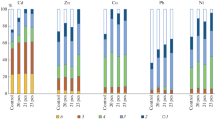Abstract
The influence of plants and microorganisms on the migration of metals in a soddy-podzolic loamy sandy soil was studied in a simulation experiment. It was shown that the biota has a great influence on the release of metal compounds into the soil and lysimetric solutions. In most cases, the metal content was reliably higher in the variants of the experiment with the presence of biota than in the control. The microorganisms maintained a high concentration of metals in the soil solution in the course of the experiment. The influence of the plants on the metal migration begins from the third week of the experiment as the biomass grows. The dose of the introduced metals also influences the concentration of the elements in the solutions and the ratios of the Me in the soil solutions: Me in the lysimetric solutions. In all the variants of the experiment, the ratios become narrower with the increase in the dose; i.e., the migration of the metals becomes more active. The dose of 7 APC (the approximate permissible concentration) has an inhibiting influence on the activity of the microorganisms and mustard plants.
Similar content being viewed by others
References
L. A. Vorob’eva, Chemical Analysis of Soils (Izd. Mosk. Gos. Univ., Moscow, 1998) [in Russian].
S. V. Ivanilova, Composition and Properties of Soil Solutions and Water Extracts from Some Soils of the Central Forest State Biospheric Reserve (Candidate (Biol.) Theses), (Izd. Mosk. Gos. Univ., Moscow, 2005) [in Russian].
N. A. Krasil’nikov, Soil Microorganisms and Higher Plants (Akad. Nauk SSSR, Moscow, 1958) [in Russian].
M. S. Malinina and S. V. Ivanilova, “Water-Soluble Phenolic Compounds and Some Macro- and Micro- elements in Gleyed Peat-Podzolic Soils of the Central Forest State Biospheric Reserve,” Vestn. Mosk. Univ., Ser. 17: pochvoved., No. 2, 40–48 (2006).
M. S. Malinina and E. I. Karavanova, “Hierarchical Levels and Indices of Heterogeneity of Chemical Composition and Properties of Forest Soils in Northern Taiga Landscapes,” Pochvovedenie, No. 8, 945–953 (2002) [Eur. Soil Sci. 35 (8), 835–844 (2002)].
M. S. Malinina and G. V. Motuzova, “Study of Soil Solutions for the Purposes of Environmental Monintoring,” in Problems of Environmental Monitoring and Modeling of Ecosystems (Gidrometeoizdat, St. Petersburg, 1992), No. 14, pp. 35–56 [in Russian].
P. H. Nye and P. B. Tinker, Solute Movement in the Soil-Root System (Blackwell Scientific, Oxford, 1977).
J. F. Banfield and K. H. Nealson, “Geomicrobiology: Interactions between Microbes and Minerals. Reviews,” Mineral. Geochem. 35, 448 (1997).
J. Derowe and A. J. Lindroos, “Comparison of Soil Water and Percolation Water Quality,” in Intensive Monitoring of Forest Ecosystems in Europe (the Finnish Forest Research Inst., Finland, 1999).
C. Gallet and C. Keller, “Phenolic Composition of Soil Solutions: Comparative Study of Lysimeter and Centrifuge Waters,” Soil Biol. Biochem. 31, 1151–1160 (1999).
D. M. Griiffin and G. Quail, “Movement of Bacteria in Moist Particulate Systems,” Aust. J. Biol. Sci. 21, 5–79 (1968).
B. L. Haines, J. B. Waide, and R. L. Todd, “Soil Solution Nutrient Concentrations Sampled with Tension and Zero-Tension Lysimeters. Report of Discrepancies,” Soil Sci. Soc. Am. J. 46, 658–661 (1982).
W. H. Hendershot and F. Courchesne, “Comparison of Soil Solution Chemistry in Zero-Tension and Ceramic Cup Tension Lysimeters,” J. Soil Sci. 42, 577–583 (1991).
P. M. Huang, J. Berthelin, J.-M. Bollag, et al., “Metals, Other Inorganics, and Microbial Activities,” in Environmental Impact of Soil Component Interactions, Vol. 11, 475 pp. (1995).
P. M. Huang, J. Berthelin, J.-M. Bollag, et al., “Natural and Anthropogenic Organics,” in Environmental Impact of Soil Component Interactions, Vol. 1, 440 pp. (1995).
P. M. Huang and J. J. Germida, “Chemical and Biological Process in the Rhizosphere: Metal Pollutants,” in Interactions between Soil Particles and Microorganisms: Impact on Terrestrial Ecosystem (IUPAC Ser. on Analytical and Physical Chemistry of Environmental Systems) (Wiley, Chichester, 2002), Vol. 8, pp. 381–438.
P. M. Huang and G. R. Gobran, Biogeochemistry of Trace Elements in the Rhizosphere (Elsevier, Amsterdam, 2005).
P. M. Huang and M. Schnitzer, Interactions of Soil Minerals with Natural Organics and Microbes (Soil Sci. Soc. Am., Madison, 1986).
E. Kirkby, “Ion Uptake and Ionic Balance in Plants in Relation to the Form of Nitrogen Nutrition,” in Ecological Aspects of the Mineral Nutrition of Plants (Blackwell Sci., Oxford, 1969), pp. 215–235.
Y. M. Nelson, L. W. Lion, W. C. Ghiorse, and M. L. Shuler, “Production of Biogenic Mn Oxides by Leptothrix discophora ss-1 in a Chemically Defined Growth Medium and Evaluation of Their Pb Adsorption Characteristics,” Appl. Environ. Microbiol. 65, 175–180 (1999).
A. D. Rovira, “Plant Root Exudates,” Bot. Rev. 34, 35–57 (1969).
B. M. Tebo, W. C. Ghiorse, L. G. van Waasbergen, et al., “Bacterially Mediated Mineral Formation: Insight Into Manganese(II) Oxidation from Molecular Genetic and Biochemical Studies,” in Geomicrobiology. Interactions between Microbes and Minerals, Eds. J. F. Banfield and K. Nealson (Mineral. Soc. Am., Washington DC, 1997), Vol. 35, pp. 225–266.
H. L. M. Verhagan and H. S. M. A. Diederen, “Vergelijkingsmetingen van de Analyse an Monsternemings Methoden van de Vaste an Vloei Bare Fase van Bodenmmonsters,” TNO-IMW rapport RSI/171. Additioneel Programma Verzuringsonderzoen Rapport No. 6-1 (1991).
Author information
Authors and Affiliations
Additional information
Original Russian Text © M.S. Malinina, Dais Makher Ali, T.N. Bolysheva, 2011, published in Pochvovedenie, 2011, No. 3, pp. 336–345.
Rights and permissions
About this article
Cite this article
Malinina, M.S., Ali, D.M. & Bolysheva, T.N. Influence of plants and the microbial activity on the metal content in soil solutions of a soddy-podzolic soil in a model experiment. Eurasian Soil Sc. 44, 304–313 (2011). https://doi.org/10.1134/S1064229311030057
Received:
Published:
Issue Date:
DOI: https://doi.org/10.1134/S1064229311030057




